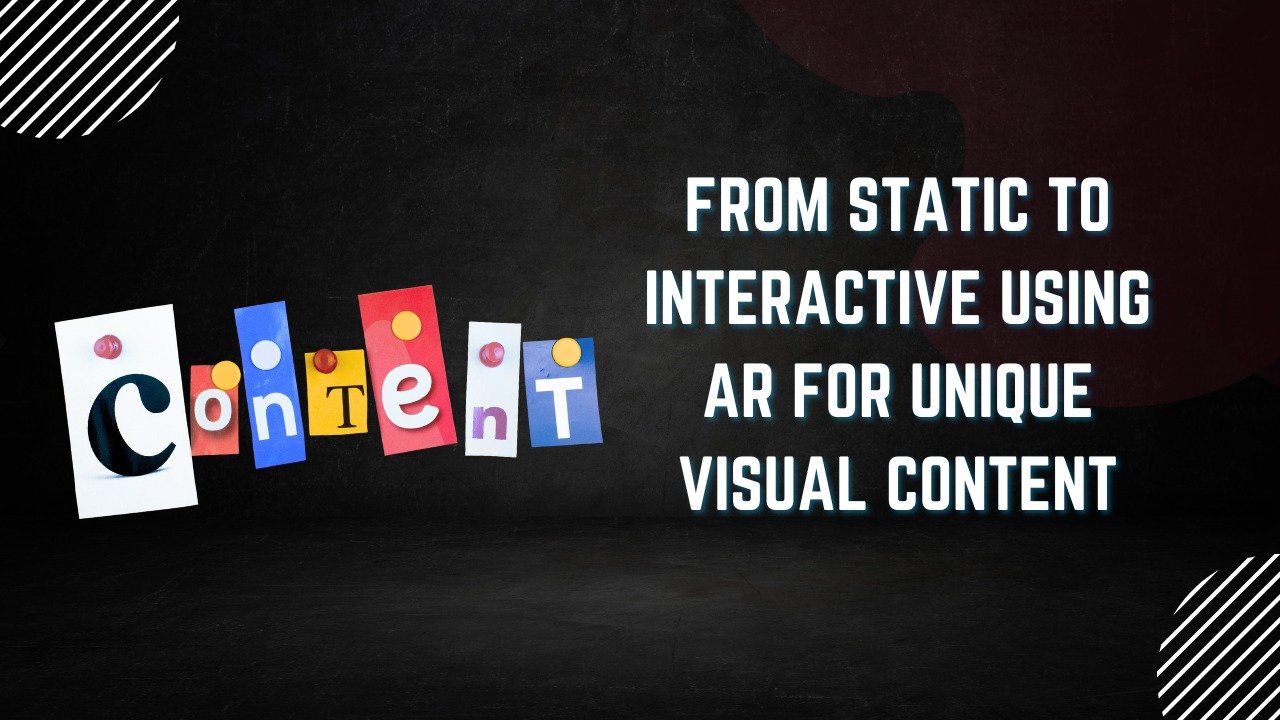From Static to Interactive: Using AR for Unique Visual Content

Let’s play a quick game. Scroll through your brand’s social media feed or website gallery. What do you see?
Chances are, you’re looking at a stream of beautifully composed photos, sleek graphics, and maybe some engaging videos. It’s good content. But is it unforgettable? In a world where the average person is bombarded with thousands of visual messages a day, static images, no matter how beautiful, are starting to blend into a blurry background.
What if you could break through the noise? What if your audience could play with your products, explore your services, and experience your brand story instead of just passively observing it?
This isn’t a glimpse into a distant future. It’s the reality being shaped by Augmented Reality (AR), and it’s completely redefining what visual content can be. We’re moving from a 2D world of looking at things, to a 3D world of interacting with them. In this post, we’ll explore how you can leverage AR to create unique visual experiences that captivate, engage, and convert.
The Static Stalemate: Why Traditional Visuals Aren’t Enough Anymore
For decades, the playbook for visual content was straightforward: high-resolution, good lighting, strong composition. And this still matters! A stunning product shot is vital.
But the limitation is inherent: it’s a one-way conversation. The user looks, maybe double-taps to ‘like’, and then scrolls away. The experience is fleeting. The visual is telling a story, but it’s not involving the user in it.
AR shatters this limitation by transforming your audience from spectators into participants. It adds a layer of digital magic to their physical world, creating a memorable, interactive visual journey that they are actively controlling.
What is AR, Really? (And No, It’s Not Just for Gaming)
If you’ve used a filter on Instagram or Snapchat to give yourself puppy ears or see how a new pair of sunglasses looks on your face, you’ve used AR. In a marketing context, it’s about using that same technology to bridge the gap between the digital and physical worlds for your brand.
It’s the ability to:
- Place a virtual piece of your furniture in a customer’s actual living room.
- Let someone see how a new shade of paint would look on their office walls.
- Have an animated character from your brand story pop out of your product packaging.
This is the evolution of visual content: from static to interactive, from generic to personal, from forgettable to immersive.
Why Your Brand Needs to Embrace Interactive Visuals
The benefits of AR extend far beyond the initial “cool” factor. They translate into tangible business outcomes.
1. Skyrocket Engagement and Dwell Time
Interactive content is inherently more engaging. Instead of a two-second glance, a user might spend two minutes playing with an AR experience. This increased dwell time builds a stronger brand connection and signals to algorithms (on social media and Google) that your content is valuable.
2. Drastically Reduce Purchase Anxiety
This is a game-changer for e-commerce. One of the biggest hurdles of online shopping is the inability to see, touch, or try a product. AR solves this. A report by Snap Inc. (external link) found that brands using AR saw a 25% reduction in returns, as customers were more confident in their purchases. By providing a superior visual experience, you build trust and close sales.
3. Create Unforgettable Brand Experiences
In a sea of sameness, AR makes you different. It’s a powerful tool for storytelling. Imagine a cosmetics brand letting users try on lipstick shades via their phone camera, or a car company letting users explore the engine of their new model by pointing their phone at a brochure. These are visual experiences that people remember and, more importantly, share.
4. Gather Powerful Data and Insights
Interactive visual content provides a wealth of data. You can see which products users “try on” most, how long they interact with the experience, and what actions they take next. This data is gold dust for refining your marketing strategy and product development.
Your Practical Guide to Getting Started with AR Visuals
Thinking this sounds too complex or expensive? Think again. The barrier to entry for AR is lower than ever.
Step 1: Start Simple with Social Media Filters
Platforms like Instagram, TikTok, and Facebook have built-in tools for creating branded AR filters and effects. This is a low-cost, high-impact way to dip your toes in. Create a fun filter related to your brand and promote it to your followers. It’s a fantastic way to generate user-generated content and buzz.
Step 2: Enhance the “Try-Before-You-Buy” Experience
If you sell physical products, this is your sweet spot. Services like Google’s ARCore (external link) and Apple’s ARKit (external link) provide the frameworks for developers to create apps that let users place your products in their space. From sofas and sneakers to eyewear and makeup, this interactive visual tool is the ultimate conversion driver.
Step 3: Bring Print to Life
Yes, really. By using QR codes or image recognition, you can make your traditional marketing materials—like brochures, business cards, or posters—interactive. Pointing a phone at a static image could launch a 3D model, a video presentation, or a special offer. This blends the tactile trust of print with the dynamic power of digital visuals.
Step 4: Develop a Custom AR Experience
For a fully integrated campaign, you can develop a custom AR experience within your own app or as a dedicated web-based AR experience (accessible through a mobile browser). This is ideal for large product launches, immersive brand storytelling, or complex configurators (like designing your own car). This is where the expertise of a dedicated partner becomes invaluable.
The Future is Interactive: Are You Ready?
The trajectory of visual content is clear. The passive consumption of images is giving way to active participation. Augmented Reality is not a gimmick; it’s the next logical step in the evolution of how we communicate and connect visually.
It’s about transforming your customers’ screens into windows to a more engaging, personal, and persuasive brand world. By starting to explore AR now, you’re not just keeping up with a trend—you’re positioning your brand as a forward-thinking leader.
Feeling inspired but unsure where to start? You don’t have to navigate this new visual frontier alone. The team at ARSL specialises in creating cutting-edge digital experiences, from strategic planning to technical execution.



